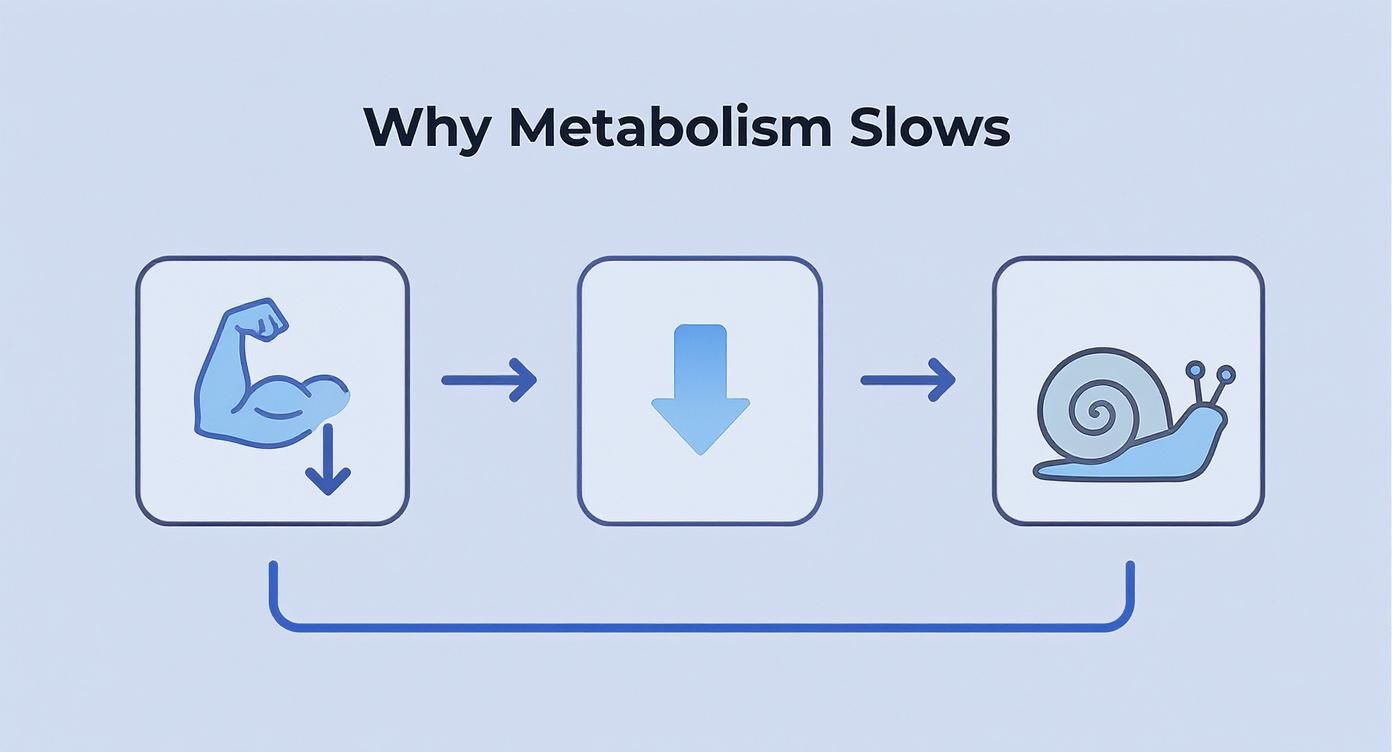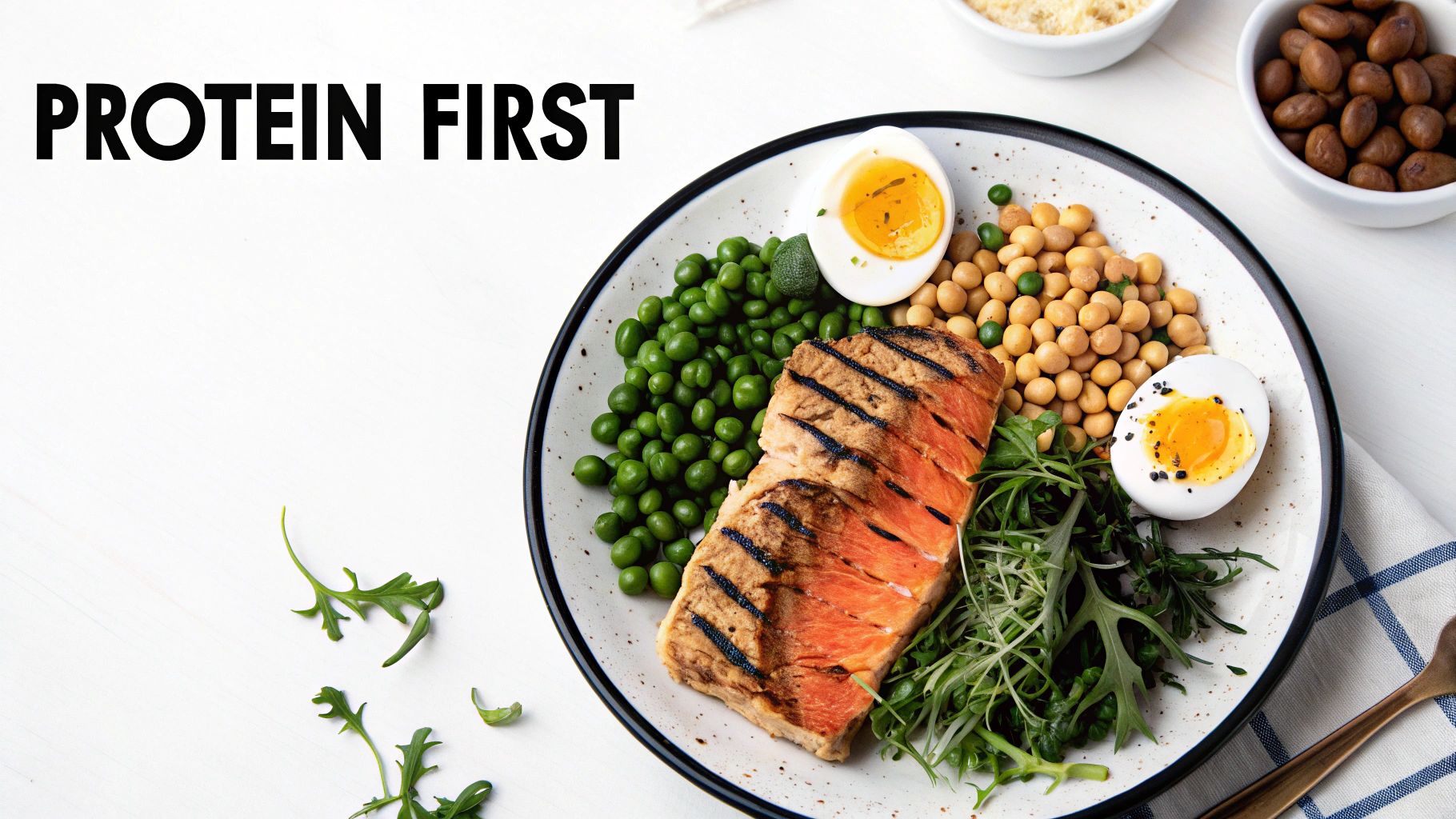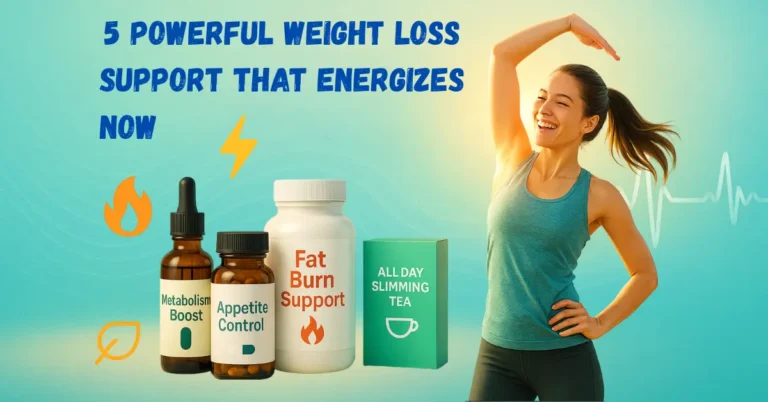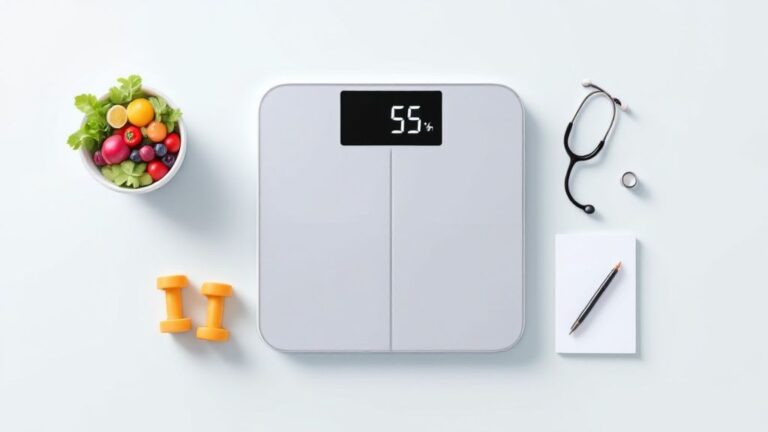How to Boost Metabolism After 40 A Proven Guide
Boosting your metabolism after 40 isn't about some magic trick. It comes down to a smart, deliberate combination of targeted strength training to build calorie-burning muscle, a protein-rich diet to fuel that muscle, and simply moving your body more throughout the day.
It’s a strategic shift away from the habits that may have worked in your 20s and 30s toward a more sustainable approach that honors where your body is today.
Why Your Metabolism Really Slows After 40
If you've noticed it's a bit harder to keep your weight steady or your energy levels up compared to a decade ago, you aren't imagining things. So many people just assume this is an unavoidable part of getting older, like a switch that just flips on your 40th birthday.
The reality is a lot more nuanced—and honestly, much more empowering. Your metabolism isn't broken; it's just responding to some very real physiological changes that have been quietly happening over time.
Understanding what's going on under the hood is the first step. This isn't about resigning yourself to a slower pace of life. It’s about recognizing the new rules of the game so you can start playing to win. A vibrant, energetic metabolism is absolutely still within your reach.
The Real Culprits Behind a Slower Metabolism
So, what’s actually happening inside your body? The metabolic slowdown you're feeling is mostly driven by two key factors that—and this is the important part—you have a ton of control over.
- Progressive Muscle Loss (Sarcopenia): Believe it or not, this process can start around age 30. On average, adults can lose 3-8% of their muscle mass every decade, and that rate often picks up speed after 40. Muscle is your metabolic engine; it burns calories even when you're just sitting on the couch. Less muscle directly translates to a lower resting metabolic rate (RMR), meaning fewer calories burned all day long.
- Hormonal and Lifestyle Shifts: Hormones definitely play a role, especially for women heading into perimenopause, as changes can affect how the body stores fat and uses energy. At the same time, life gets busy. Demanding careers and family responsibilities often lead to a more sedentary lifestyle, which chips away at your daily calorie burn.
Here's the good news: these changes are not a life sentence. With the right actions, you can fight back against muscle loss and tweak your habits to build a strong, healthy metabolism that will serve you for years to come.
This guide is designed to give you a clear, no-fluff plan. We’re going to skip the generic advice and focus on practical steps that actually get results. It's not about finding a quick fix but about building a solid system that works with your body, not against it.
Let's start with a quick look at the core strategies we're going to dive into.
Your Core Strategies for a Faster Metabolism
Here's a snapshot of the foundational strategies we'll be covering in detail. Think of these as the four pillars of your metabolism-boosting plan.
| Strategy Area | Primary Goal | Key Action |
|---|---|---|
| Resistance Training | Fight Muscle Loss (Sarcopenia) | Perform 2-3 sessions per week targeting major muscles |
| Strategic Nutrition | Increase Calorie Burn & Preserve Muscle | Eat 1.0-1.2g of protein per kg of your body weight daily |
| Daily Movement | Boost Overall Energy Expenditure | Aim for 150+ mins of cardio plus more non-exercise activity |
| Lifestyle Habits | Balance Hormones & Aid Recovery | Prioritize 7-9 hours of quality sleep each night |
Each of these areas is a powerful lever you can pull to get your metabolic engine running stronger. Now, let's break down exactly how to put them into practice.
Building Muscle to Reignite Your Metabolism
If you only take one piece of advice on how to boost your metabolism after 40, make it this one: prioritize building and maintaining muscle.
While nutrition, sleep, and everything else we'll cover are crucial pieces of the puzzle, nothing moves the needle on your metabolic rate quite like resistance training. It’s your single most powerful tool for fighting back against the changes that come with age.
Why is this so important? It all comes down to a process called sarcopenia—the natural, age-related loss of muscle mass. It’s a sneaky process that can start as early as your 30s but really picks up steam in your 40s, quietly chipping away at your body's most metabolically active tissue.
Think of muscle as your metabolic furnace—it burns calories around the clock, even when you're just sitting on the couch. As you lose muscle, that furnace shrinks, and your resting metabolic rate (RMR) drops. This means your body simply needs fewer calories to function each day, making it incredibly easy to gain weight even if you haven't changed a single thing about your diet.
This infographic really drives home the direct link between losing muscle and a slowing metabolism.

As you can see, muscle loss is the first domino to fall. It triggers hormonal shifts and leads to a less efficient metabolic engine. The solution? Actively work against this process by telling your body to build and preserve that precious lean tissue through strength training.
Your Foundational Strength Training Plan
Getting started doesn't mean you have to spend hours in the gym or become a bodybuilder. Honestly, consistency is far more important than intensity, especially when you're starting out.
Aim for two to three full-body workouts per week. Just make sure to schedule them on non-consecutive days to give your muscles the time they need to recover and grow.
The most efficient way to build muscle is by focusing on compound movements. These are the big exercises that work multiple muscle groups at once, giving you the biggest metabolic bang for your buck.
A simple, incredibly effective plan could include:
- Squats (or Goblet Squats): Targets your quads, hamstrings, and glutes—the largest muscles in your body.
- Deadlifts (or Kettlebell Swings): A true powerhouse movement for your entire posterior chain (back, glutes, and hamstrings).
- Push-Ups (on knees or toes): The classic move for building strength in your chest, shoulders, and triceps.
- Rows (with dumbbells or bands): Absolutely essential for a strong back and better posture.
For each exercise, a good starting point is 3 sets of 8-12 repetitions. The weight should feel challenging; the last couple of reps in each set should be tough but doable with good form.
The Power of Progressive Overload
To keep seeing results, you have to embrace the principle of progressive overload. All this means is you must continually challenge your muscles a little more over time. If you lift the same weight for the same number of reps forever, your body will adapt and have no reason to get stronger.
Key Takeaway: Progressive overload is the non-negotiable secret to building muscle. Without it, your body has no reason to adapt, and your metabolic benefits will stall out.
Here’s how you can put progressive overload into practice from week to week:
- Increase Reps: Once you can complete all 3 sets of 12 reps with good form, focus on adding one or two more reps to each set in your next workout.
- Increase Weight: When you can comfortably hit 3 sets of 15 reps, it’s time to bump up the weight slightly and drop back down to that 8-12 rep range.
- Improve Form: You can also increase the challenge by slowing down the movement, especially the lowering (eccentric) phase. This stimulates even more muscle growth.
More Than Just Metabolism
While revving up your metabolism is a huge win, strength training after 40 offers so much more. It significantly improves bone density, which is critical for preventing osteoporosis as we age. It also makes your body better at managing blood sugar by improving insulin sensitivity.
Regular strength training is one of the most effective ways to push back against sarcopenia. A 2017 study found that older adults who did resistance training just two to three times a week for 12 weeks increased their lean muscle mass by an average of 1.4 kg.
This change led to a 7% increase in their resting metabolic rate, which translates to burning an extra 100-150 calories every day, even at rest. You can learn more about these findings and the impact of aging on metabolism at WebMD.com.
Eating Smarter, Not Less, to Fuel Your Body
After you've got a solid strength training routine in place, the next biggest lever you can pull is shifting your focus from eating less to eating smarter. I've seen it time and time again: the restrictive, low-calorie diets that might have worked in your 20s can seriously backfire after 40. They often slow your metabolism even further by screaming "scarcity!" to your body.

Instead, the goal is to give your body high-quality fuel. We want food that supports muscle repair, keeps hunger at bay, and naturally nudges your daily calorie burn higher. It’s all about nourishing your body, not depriving it.
The absolute cornerstone of this strategy? Protein. It is, without a doubt, the most important macronutrient for anyone looking to fire up their metabolism after 40.
Prioritize Protein at Every Single Meal
Protein is a metabolic powerhouse for two big reasons. First, it’s the essential building block for repairing and growing the lean muscle you’re working so hard for in the gym. Without enough protein, your efforts just won't pay off like they should.
Second, protein has the highest thermic effect of food (TEF). This is a fancy way of saying your body burns way more calories just digesting and processing protein compared to fats and carbs. This isn't a trivial amount, either—it's a real, meaningful way to increase your daily energy burn without any extra effort.
As we get older, our bodies can become less efficient at using the protein we eat, which makes getting enough of it even more critical to prevent muscle loss. In fact, research points to adults over 40 needing 1.0 to 1.2 grams of protein per kilogram of body weight just to preserve muscle mass. Hitting this target can boost your TEF by as much as 20-30%, potentially adding an extra 50-100 calories to your daily burn.
For a 150 lb (68 kg) person, this works out to a daily goal of 68-82 grams of protein. A simple way to get there is to aim for a solid 20-30 grams of protein with each meal.
This approach makes sure you're consistently feeding your muscles what they need, especially after a workout.
Making Protein Practical
That daily protein target might sound like a lot, but it’s much simpler than you think when you break it down. The key is to include a quality protein source with every meal and snack. Every single one.
Here’s a glimpse of what that could look like:
- Breakfast: A bowl of Greek yogurt with berries or a couple of scrambled eggs.
- Lunch: A big salad topped with a grilled chicken breast or a can of tuna.
- Dinner: A piece of salmon or some lean steak with roasted vegetables.
- Snack: A quick protein shake, a handful of almonds, or a scoop of cottage cheese.
Spreading your intake out like this is far more effective for muscle building than trying to cram it all into one massive meal at the end of the day. If you need more inspiration, check out our guide on high-protein foods to easily add more to your plate: https://healthyweighthappylife.com/high-protein-foods/
Don’t Forget Fiber and Healthy Fats
While protein is the star of the show, it needs a good supporting cast. That's where fiber and healthy fats come in, playing crucial roles in your overall metabolic health.
Fiber-rich foods—think vegetables, fruits, beans, and whole grains—are fantastic for a few reasons. They help keep your blood sugar stable, preventing those energy crashes that send you reaching for sugary, metabolism-wrecking snacks. Fiber also helps you feel full and satisfied long after you've finished eating.
Healthy fats from sources like avocados, nuts, seeds, and olive oil are vital for hormone production, including the very hormones that regulate your metabolism. They also help your body absorb certain vitamins and are another key player in helping you feel full, which prevents overeating.
The Importance of Hydration
Finally, please don't underestimate the power of water. Every single process in your body, especially converting food into energy, requires water to work properly.
Even being just a little dehydrated can cause your metabolism to slow down as your body tries to conserve its resources. Make it a habit to drink water all day long, not just when you feel thirsty. Here's an easy tip: Start your day with a large glass of water right after you wake up. It’s a great way to kickstart your hydration and get your metabolic engine running.
Boosting Your Burn Beyond the Gym
Strength training is fantastic for building a faster metabolism, but what you do in the other 23 hours of the day is just as critical. Think of your workouts as stoking the metabolic fire, and all your daily movement as the kindling that keeps it burning bright. This is where we layer in smart cardio and the often-overlooked power of everyday activity.

This combination is the real game-changer. It ensures you’re not just torching calories for one hour at the gym but maximizing your energy burn over a full 24-hour cycle. It's the secret for anyone trying to figure out how to boost metabolism after 40 without living in their workout clothes.
Finding Your Cardio Sweet Spot
Let's keep the goal for cardio simple: aim for at least 150 minutes of moderate-intensity activity per week. This isn't about punishing yourself on a treadmill until you can't breathe. It’s about finding activities you genuinely enjoy because that’s the only way you’ll stick with them.
"Moderate intensity" just means you can still hold a conversation, but you’re a little breathless doing it.
The best type of cardio is the one you will actually do consistently. Don’t force yourself to run if you hate running. A brisk walk, a bike ride, or a dance class are all fantastic options that get the job done.
This consistent aerobic activity is a proven way to keep your metabolic rate humming. A landmark 2021 study showed that adults who hit this activity level had a resting metabolic rate 5-10% higher than their sedentary peers. For someone in their 50s, that could mean burning an extra 150-200 calories every single day, just from walking briskly for 30 minutes, five times a week. You can explore more about how metabolism changes with age in this insightful Duke University article.
Unlocking the Power of NEAT
Now, let's talk about the secret weapon for your metabolism: NEAT, which stands for Non-Exercise Activity Thermogenesis. This is all the energy you burn from movements that aren't "formal" exercise—things like fidgeting, walking to the mailbox, doing chores, or taking the stairs.
It might sound insignificant, but NEAT can be a massive calorie burner, often accounting for hundreds of extra calories burned each day. For many people, NEAT contributes far more to their total daily energy burn than their scheduled workout does.
Increasing your NEAT is all about weaving more movement into your existing routine. No gym clothes or big time commitment required.
- Take the long way: Park at the far end of the parking lot. Get off the bus one stop early.
- Embrace inefficiency: Instead of hauling all the groceries in one trip, make two. Walk over to a colleague’s desk instead of sending an email.
- Schedule movement breaks: Set a timer to get up and stretch or walk around for five minutes every hour.
- Incorporate walking: Pace around while you’re on the phone. Take a short 10-minute walk after lunch to help digestion and clear your head.
These small, seemingly minor tweaks are incredibly powerful. They transform you from a person who exercises for an hour into a person who is active all day. This constant, low-level activity keeps your metabolic engine primed and burning fuel efficiently. While some people find that specific supplements help support their energy for this increased activity, it's always best to build these foundational habits first. You can learn more about how certain natural ingredients are used in products like Java Burn coffee. Ultimately, it’s this consistent daily movement, paired with your strength and cardio workouts, that creates a truly resilient and high-functioning metabolism after 40.
Mastering the Hidden Drivers of Metabolism
Beyond the gym and the kitchen, some powerful—and often invisible—forces are constantly shaping your metabolic rate. While building muscle and eating enough protein are the cornerstones, getting a handle on your lifestyle habits is what truly cements your progress.
Things like sleep, stress, and hormonal health are the hidden drivers that can either supercharge your efforts or quietly sabotage them.
Think of these factors as the internal environment where your metabolism lives. If that environment is chaotic and inflamed, even the best workout plan will feel like you're running in mud. This is where we learn how to boost metabolism after 40 by creating balance from the inside out.
The Critical Role of Quality Sleep
Let's be clear: sleep isn't a luxury. It's a non-negotiable metabolic reset button. When you consistently fall short of the recommended 7-9 hours per night, a cascade of negative hormonal events kicks off.
Your body responds to sleep deprivation by jacking up levels of cortisol, our main stress hormone. Elevated cortisol signals your body to conserve energy, which usually means slowing your metabolism and encouraging the storage of stubborn belly fat.
At the same time, poor sleep messes with the two key hormones that manage your appetite. Ghrelin, the "I'm hungry" hormone, skyrockets, while leptin, the "I'm full" hormone, takes a nosedive. This hormonal one-two punch leaves you feeling hungrier and less satisfied, triggering cravings for the exact high-calorie, sugary foods that work against your goals.
A single night of bad sleep can be enough to throw these crucial hormones out of whack. Consistent, quality rest is one of the most powerful tools you have for keeping your metabolism humming and cravings in check.
Taming Chronic Stress to Support Metabolism
In today's world, stress can feel like a constant companion. The problem is, your body can’t tell the difference between a looming deadline and a saber-toothed tiger. When you're under chronic stress, your cortisol levels stay persistently high.
This state of high alert sends a clear message to your body: "Times are tough, store energy for later." This translates directly to fat storage, especially around your midsection. Chronic stress essentially slams the brakes on your metabolism, making it incredibly difficult to see progress, no matter how clean you eat or how hard you train.
Managing stress isn't just about feeling better mentally; it’s a physical requirement for a healthy metabolism. The good news is that simple, practical techniques can make a world of difference.
- Mindful Moments: Just 5-10 minutes of daily meditation or deep breathing exercises can significantly lower cortisol.
- Nature's Reset: Spending time outside, even just a short walk in a park, is proven to reduce stress.
- Active Decompression: Light physical activity like yoga or walking helps burn off that nervous energy and calms your system down.
The key is finding what works for you. The goal is to break the cycle of constant stress, allowing your metabolism to shift out of survival mode and back into an efficient, energy-burning state.
Addressing Hormonal Shifts After 40
Finally, we have to talk about the natural hormonal changes that happen after 40. For women, perimenopause and menopause bring fluctuations in estrogen. For men, a gradual decline in testosterone is common. These shifts can directly impact muscle mass, where you store fat, and your overall energy expenditure.
While these changes are a normal part of aging, they don't have to dictate your metabolic fate. This is where partnering with your doctor becomes absolutely essential.
A conversation with your healthcare provider can help you understand your unique hormonal profile and rule out any underlying medical issues that could be slowing you down, like an underactive thyroid (hypothyroidism). Blood sugar management is another common hurdle, and a doctor can offer guidance. For those looking into ways to support their body's natural systems, reading reviews about supplements designed for blood sugar regulation can be a good starting point; for instance, you might explore what people are saying about products like GlucoTrust.
Working with a professional ensures you’re getting to the root of any metabolic slowdown. This creates a solid foundation, allowing all your hard work with nutrition and exercise to finally pay off and help you feel vibrant and energized for years to come.
Got Questions About Your Metabolism After 40? Let's Clear Things Up.
Even when you're armed with a great plan, a few questions are bound to pop up. I get it. Over the years, I've heard the same concerns from countless clients, and getting clear, honest answers is the best way to stay confident and on track.
My goal here is to cut through the noise and tackle the most common uncertainties I hear. Let's make sure you're moving forward with clarity, focusing on what will actually move the needle for your metabolic health.
Do "Metabolism-Boosting" Foods Actually Work?
This is a big one, and it’s easy to get excited by headlines about "fat-burning" superfoods. While some foods do have a small effect, it’s really important to see the bigger picture.
- Spicy Foods: Yes, the capsaicin in chili peppers can give you a tiny, temporary metabolic spike. But the effect is so minimal it won't drive any real weight loss.
- Green Tea: The catechins in green tea can offer a slight nudge, but we’re talking about an extra 10-20 calories burned per cup. It’s not a game-changer.
- Caffeine: A morning coffee can briefly increase your energy burn, but your body is smart and adapts to this effect pretty quickly.
Think of these foods as the supporting cast, not the main characters in your story. The real foundation for a faster metabolism comes from the hard work of building muscle with strength training and eating enough protein to make it happen.
Relying on these foods alone is like trying to fill a swimming pool with a teaspoon. Focus on the big rocks first—protein and resistance training.
How Long Will It Take to Notice a Difference?
Patience is your best friend on this journey, but you’ll probably feel positive changes much sooner than you think. While the big metabolic shifts take time, the early wins are incredibly motivating.
Most people start to feel more energetic and less sluggish within the first 2-4 weeks of being consistent. That's usually the first sign your body is responding well to better fuel and regular movement.
As for seeing changes in the mirror or feeling your clothes fit better? That often starts happening around the 4-8 week mark. The more significant, lasting improvements to your resting metabolic rate (RMR)—the holy grail of this process—take a bit longer, typically around 3-6 months. That’s because it’s tied directly to the new muscle you’re building. Just remember, consistency will always beat short-term intensity.
Can I Actually Damage My Metabolism by Exercising Too Much?
Oh, absolutely. This is one of those areas where more is definitely not better, especially after 40. Pushing your body into the ground without giving it a chance to recover is a surefire way to get some serious metabolic backlash.
Overtraining, especially if you’re also drastically cutting calories, sends a massive stress signal to your body. This can spike your stress hormone, cortisol, and convince your body it’s in "survival mode." When that happens, it slams the brakes on your metabolism and starts clinging to energy (body fat) for dear life.
You have to listen to your body. The tell-tale signs of overtraining are things like constant fatigue, terrible sleep, and nagging aches or injuries that just won't quit. Make sure you're scheduling 1-2 complete rest days every week. Recovery is when the magic happens—it's when your muscles repair and grow stronger. Rest isn't lazy; it's a non-negotiable part of the plan.
At Healthy Weight Happy Life, we’re all about building sustainable habits that work with your body, not against it. Feel free to explore our resources and expert-reviewed products designed to support you on your journey to a healthier, more vibrant you.
Article created using Outrank







